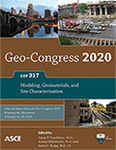Geo-Congress 2020
Practical Guidelines for Assessing Undrained Shear Strength from Triaxial Compression with Isotropic and Anisotropic Consolidation
Publication: Geo-Congress 2020: Modeling, Geomaterials, and Site Characterization (GSP 317)
ABSTRACT
Selection of shear strength parameters for geotechnical analyses is often informed by laboratory testing of compacted and undisturbed soil samples. Laboratory tests commonly used to characterize peak shear strength include direct shear tests, direct simple shear tests, and triaxial compression tests. Consolidated-undrained triaxial compression tests with pore-pressure measurements are particularly useful and common, because the test results allow for interpretation of both drained and undrained strength parameters. Even though stress conditions in the field are generally anisotropic, samples for consolidated-undrained triaxial compression tests are most often isotropically consolidated. For cases where strength interpretation requires that the in situ stress conditions be considered, empirical and theoretical correlations between undrained shear strength from these differing consolidation-stress conditions are available to understand the potential differences in shear strength parameters. This paper presents an overview of previously proposed empirical and theoretical correlations. The methods are evaluated using a shear strength database of soils for which both isotropically and anisotropically consolidated-undrained triaxial compression tests were performed. Based on a review of the predicted and measured shear strengths, practical recommendations are made for use in engineering practice.
Get full access to this article
View all available purchase options and get full access to this chapter.
REFERENCES
ASTM D4767-11 (2011). Standard Test Method for Consolidated Undrained Triaxial Compression Test for Cohesive Soils, ASTM International, West Conshohocken, PA, 2011, www.astm.org
Bjerrum, L. (1961). The effective shear strength parameters of sensitive clays. Proc. 5th ICSMFE, Paris, Vol. 1, 23-28.
Donaghe, R. T. and Townsend, F. C. (1978). Effects of anisotropic versus isotropic consolidation in consolidated-undrained triaxial compression tests of cohesive soils, Geotech. Test. J., 1(4), 173-189.
Duncan, J. M. (2000). Factors of safety and reliability in geotechnical engineering. Journal of Geotechnical and Geoenvironmental Engineering, 126(4), 307-316.
Henkel, D.J. (1960). “The relationships between the effective stresses and water content in saturated clays.” Geotechnique, 10(2), 41-54.
Henkel, D. J. and Sowa, V. A. (1963). The influence of stress history on stress paths in undrained triaxial tests on clay Laboratory Shear Testing of Soils, STP No. 361, ASTM, 280-291.
Khera, R. P. and R. J. Krizek (1967). Strength behavior of an anisotropically consolidated remolded clay, Highway Research Record 190, 8-18.
Kulhawy, F. H. and Mayne, P. W. (1990). Manual on estimating soil properties for foundation design (No. EPRI-EL-6800). Electric Power Research Inst., Palo Alto, CA (USA); Cornell Univ., Ithaca, NY (USA). Geotechnical Engineering Group.
Ladd, C. (1965). Stress-strain behavior of anisotropically consolidated clays during undrained shear. Proc. 6th ICSMFE, Montreal, Canada, Vol. I, 282-286.
Ladd, C. C. and DeGroot, D. J. (2003). Recommended practice for soft ground site characterization: Arthur Casagrande Lecture. In 12th Panamerican Conference on Soil Mechanics and Geotechnical Engineering (Vol. 1, pp. 1-57). Essen, Germany: Verlag GmbH.
Mayne, P.W. (1985), Stress Anisotropy Effects on Clay Strength, J. Geotech. Engrg. 1985.111:356-366.
Sivakugan, N. (1988). CK0UC shear strength of normally consolidated clays from CIUC tests. Journal of the Geotechnical Engineering Division, ASCE, Vol. 114, GT3, 284-295.
Skempton, A.W. and Bishop, A.W. (1954), “Soils” in Building Materials, Their Elasticity and Inelasticity, North-Holland Publ. Co., Amsterdam, Ed. M. Reiner, Chapter 10, pp. 417-482.
Taylor, D.W. (1948). Fundamentals of soil mechanics. John Wiley & Sons, Inc. New York, 700 pp.
VandenBerge, D. (2019). “Comparison of ACU and ICU Triaxial Compression.” https://doi.org/10.17605/OSF.IO/246JY,
VandenBerge, D. R., Duncan, J. M., and Brandon, T. L. (2014). Rapid drawdown analysis using the finite element method, CGPR# 79. CGPR, Virginia Tech, Blacksburg, VA.
Whitman, R. V., Ladd, C. C., and DaCruz, P. (1960). Discussion to Session 3, Proc. ASCE Research Conf. Shear Strength of Cohesive Soils, ASCE, Boulder, CO, 1049-1056.
Information & Authors
Information
Published In
Geo-Congress 2020: Modeling, Geomaterials, and Site Characterization (GSP 317)
Pages: 398 - 406
Editors: James P. Hambleton, Ph.D., Northwestern University, Roman Makhnenko, Ph.D., University of Illinois at Urbana-Champaign, and Aaron S. Budge, Ph.D., Minnesota State University, Mankato
ISBN (Online): 978-0-7844-8280-3
Copyright
© 2020 American Society of Civil Engineers.
History
Published online: Feb 21, 2020
Published in print: Feb 21, 2020
ASCE Technical Topics:
- Compression tests
- Compressive strength
- Consolidated soils
- Engineering fundamentals
- Geomechanics
- Geotechnical engineering
- Laboratory tests
- Material mechanics
- Material properties
- Materials engineering
- Shear strength
- Shear tests
- Soil compression
- Soil dynamics
- Soil mechanics
- Soil properties
- Soil strength
- Soils (by type)
- Strength of materials
- Tests (by type)
- Triaxial tests
Authors
Metrics & Citations
Metrics
Citations
Download citation
If you have the appropriate software installed, you can download article citation data to the citation manager of your choice. Simply select your manager software from the list below and click Download.
